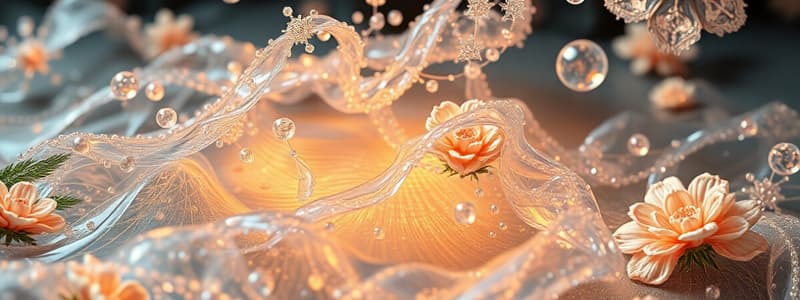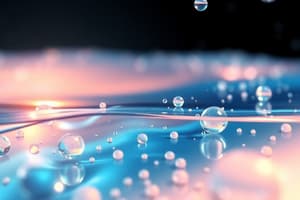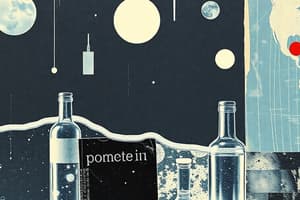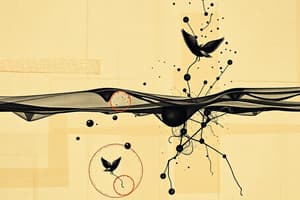Podcast
Questions and Answers
What is surface tension primarily a measure of?
What is surface tension primarily a measure of?
- The viscosity of the liquid
- The force needed to compress a liquid
- The buoyancy of the liquid
- The resultant force acting inward on a liquid surface (correct)
How do electrolytes affect water surface tension?
How do electrolytes affect water surface tension?
- They decrease surface tension significantly
- They have no effect on surface tension
- They increase surface tension in a modest manner (correct)
- They completely stabilize surface tension
Which component provides the hydrophilic nature of a surfactant?
Which component provides the hydrophilic nature of a surfactant?
- Hydrophobic tail
- Amphiphilic structure
- Hydrophilic head (correct)
- Long hydrocarbon chain
What is the role of an emulsifier in an emulsion?
What is the role of an emulsifier in an emulsion?
Which type of emulsion is characterized by oil droplets dispersed in water?
Which type of emulsion is characterized by oil droplets dispersed in water?
What happens to the surface tension of water upon the addition of organic compounds?
What happens to the surface tension of water upon the addition of organic compounds?
Which of the following describes the structure of a surfactant?
Which of the following describes the structure of a surfactant?
What effect do surfactants have on surface tension?
What effect do surfactants have on surface tension?
What characterizes the binding site of a protein?
What characterizes the binding site of a protein?
How do globular proteins demonstrate specificity?
How do globular proteins demonstrate specificity?
What is denaturation in the context of proteins?
What is denaturation in the context of proteins?
Which type of modulator is characterized as being able to cause permanent changes to a protein?
Which type of modulator is characterized as being able to cause permanent changes to a protein?
Which factor does not significantly affect protein function?
Which factor does not significantly affect protein function?
Which type of inhibitor binds to the same site as the ligand?
Which type of inhibitor binds to the same site as the ligand?
What is the most common type of covalent modulator?
What is the most common type of covalent modulator?
What role do small molecules termed antagonists play in relation to proteins?
What role do small molecules termed antagonists play in relation to proteins?
Flashcards
Surface Tension
Surface Tension
The inward force acting on a liquid's surface, perpendicular to it. It's a characteristic property of each liquid, representing the force needed to stretch a liquid membrane.
Liquid-Gas Interface
Liquid-Gas Interface
The area where a liquid meets a gas, like air. It gives the liquid a 'skin-like' effect.
Surfactant
Surfactant
A substance that significantly reduces a liquid's surface tension.
Hydrophobic Tail
Hydrophobic Tail
Signup and view all the flashcards
Hydrophilic Head
Hydrophilic Head
Signup and view all the flashcards
Amphiphilic Structure
Amphiphilic Structure
Signup and view all the flashcards
Emulsion
Emulsion
Signup and view all the flashcards
Emulsifier
Emulsifier
Signup and view all the flashcards
Ligand
Ligand
Signup and view all the flashcards
Binding Site
Binding Site
Signup and view all the flashcards
Denaturation
Denaturation
Signup and view all the flashcards
Modulators
Modulators
Signup and view all the flashcards
Covalent Modification
Covalent Modification
Signup and view all the flashcards
Competitive Inhibitor
Competitive Inhibitor
Signup and view all the flashcards
Allosteric Inhibitor
Allosteric Inhibitor
Signup and view all the flashcards
Activator
Activator
Signup and view all the flashcards
Study Notes
1.4.4. Surface Tension
- A water molecule at the center of a liquid is pulled by all surrounding molecules. The resultant force is zero.
- A molecule at the liquid-gas interface experiences a net force pulling it into the liquid (non-polar molecules).
- Surface tension is the resultant force pulling the molecule inwards, perpendicular to the surface. It's a characteristic property of each liquid.
- A liquid in contact with a gas/air acts as an elastic membrane.
1.4.4. Effects of the dissolution of chemicals
- Dissolving mineral electrolytes in water slightly increases the surface tension. The increase is proportionate to the concentration. (Ex: sea water vs. pure water)
- Larger molecules (e.g., carbohydrates, proteins) can lower surface tension. The more concentrated, the more effective.
1.4.4. Surfactants (Surface-Active Agents)
- Surfactants are substances that lower surface tension.
- A surfactant is a compound with a hydrophobic (water-repelling) long chain and a hydrophilic (water-attracting) carboxyl group.
- This amphipathic structure allows them to modify the behavior of liquid surfaces.
1.4.5. Emulsions
- An emulsion is a mixture of two immiscible (non-mixable) liquids (like oil and water) made more homogeneous with an emulsifier.
- Emulsifiers reduce surface tension at the interface of the two immiscible liquids, making the mixtures stable.
- The emulsifier coats the droplets of one liquid (forming a protective film), preventing them from combining.
- Two possible types of emulsions:
- Oil-in-water (O/W): Oil droplets dispersed in water
- Water-in-oil (W/O): Water droplets dispersed in oil
- Examples:
- Milk
- Mayonnaise
- Butter
Studying That Suits You
Use AI to generate personalized quizzes and flashcards to suit your learning preferences.





